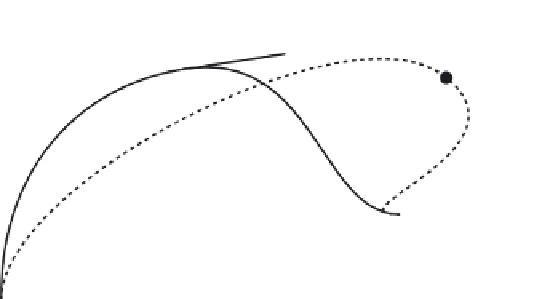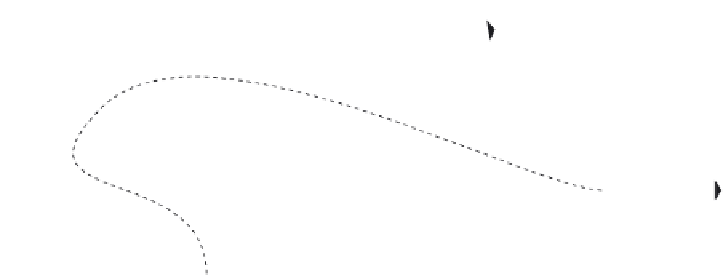Graphics Reference
In-Depth Information
P
i
R
i
Q
i
P
i
1
P
i
1
FIGURE B.40
Three curve segments, (
P
i-1
,
P
i
,P
i þ1
), (
P
i-1
,
Q
i
,P
i þ1
), and (
P
i-1
,
R
i
,P
i þ1
), using the perpendicular to the angle
bisector for computing the internal tangent.
to independently determine the length of the tangent vector for each segment it is associated with. Thus,
a point
P
i
has an ending tangent vector associated with it for the segment from
P
i
-1
to
P
i
as well as a
beginning tangent vector associated with it for the segment
P
i
to
P
i þ
1
. These tangents have the same
direction but different lengths. This relaxes the
C
1
continuity instead. For example, an initial tangent vector at an interior point is determined as the vector
from
P
i
-1
to
P
i þ
1
. The ending tangent vector for the segment
P
i
-1
to
P
i
is computed by scaling this
initial tangent vector by the ratio of the distance between the points
P
i
and
P
i
-1
to the distance between
points
P
i
-1
and
P
i þ
1
. Referring to the segment between
P
i
-1
and
P
i
as
P
i
-1
(
u
) results in
Equation B.78
.
A similar calculation for the beginning tangent vector of the segment between
P
i
and
P
i þ
1
results in
Equation B.79
.
These tangents can be seen in
Figure B.41
.
The computational cost of this approach is
only a little more than the standard Catmull-Rom spline and seems to give more intuitive results.
1
continuity of the Catmull-Rom spline and uses
G
Þ¼
jP
i
P
i
1
j
jP
iþ
1
P
i
1
j
0
P
ð
1
:
0
ð
P
iþ
1
P
i
1
Þ
(B.78)
i
1
Þ¼
jP
iþ
1
P
i
j
jP
iþ
1
P
i
1
j
0
P
i
ð
0
:
0
ð
P
iþ
1
P
i
1
Þ
(B.79)
P
i
(0.0)
P
i
P
i
1
(1.0)
P
i
(
u
)
P
i
1
(
u
)
P
i
1
P
i
1
FIGURE B.41
Interior tangents based on relative segment lengths.






















Search WWH ::

Custom Search